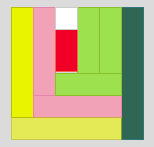Skip over navigation

Or search by topic
Number and algebra
Geometry and measure
Probability and statistics
Working mathematically
Advanced mathematics
For younger learners
Rearranged Rectangle
Age 7 to 11
Challenge Level 





Talk to someone else about what you see in this picture:

Click below to read what some other children said:
Meena:
"It's a rectangle! Or is it a square?"
Seb:
"There are lots of different coloured rectangles. They are fitted together with no gaps."
Anna:
"There is more than one of each colour rectangle."
Do you agree with each of them? Why or why not?
In fact, the picture has been made using Cuisenaire rods.
How many other, different, rectangles can you make using all of the rods that were used in the picture?
How do you know you have found them all?
You could use the interactivity below to try out your ideas if you haven't got any rods.

Click below to read what some other children said:
Meena:
"It's a rectangle! Or is it a square?"
Seb:
"There are lots of different coloured rectangles. They are fitted together with no gaps."
Anna:
"There is more than one of each colour rectangle."
Do you agree with each of them? Why or why not?
In fact, the picture has been made using Cuisenaire rods.
How many other, different, rectangles can you make using all of the rods that were used in the picture?
How do you know you have found them all?
You could use the interactivity below to try out your ideas if you haven't got any rods.
You may also like
Geoboards
This practical challenge invites you to investigate the different squares you can make on a square geoboard or pegboard.

